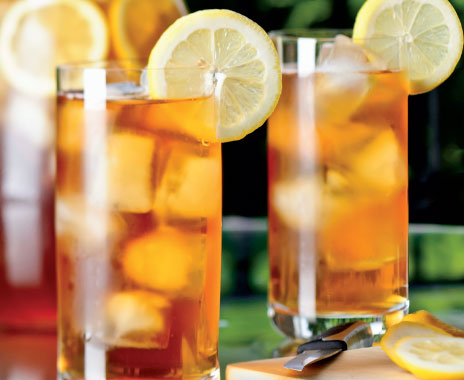It’s summer. It’s hot. And chances are good that if you’re nestled comfortably in a backyard hammock—or perched on a porch swing, sprawled out on the beach, casting a line at the ol’ fishing hole, or engaged in any number of other stereotypical warm-weather activities straight out of a Norman Rockwell illustration—you’re reaching for an ice-cold tea to wet your whistle.
I say chances are good because, according to the trade group Tea Association of the USA, Americans drank more than 79 billion servings of tea in 2012, or more than 3.6 billion gallons, of which an estimated 85 percent was served iced. If the group’s methods and calculations are sound, on any given day, over one-half of the American population drinks tea, and tea is currently on the pantry shelves or in the refrigerators of 80 percent of U.S. households. Moreover, according to the association, supermarket tea sales alone exceeded $2.25 billion in 2012, and away-from-home consumption has been growing by at least 10 percent annually over the past decade. Total sales, the group claimed last year, increased 16 percent over the course of the previous five years.
To clarify: We’re talking about tea, not the many and varied herbal concoctions that are labeled as tea but aren’t actually derived from Camellia sinensis, the shrub that hails from India and China and is the source of the leaves we typically refer to simply as green, black, white, oolong, and pu-erh teas. That’s not to disparage your nighttime chamomile or that homebrewed hibiscus remedy your grandmother called “tea.” It’s just that once you get away from Camellia sinensis, you’re no longer truly speaking of tea.
Now that we’ve dispensed with the technicalities, let’s consider the drivers of all that iced tea consumption. To me, there are three big ones: health, taste, and functionality. Tea’s reputed (and well-publicized) health effects include a lowered risk of cancer and cardiovascular disease, as well as weight loss and enhanced bone strength, among many others. It may not be a magical elixir, but tea’s reputation as an antioxidant-rich drink that packs a healthful punch is now well established. With regard to taste, tea’s complex flavor profile, the fact that it can be enjoyed either sweetened or unsweetened, and its suitability as an accompaniment for food makes it a preferred quencher at a time when carbonated soft drinks are falling out of vogue and consumers still want something more in the taste department than water. Finally, there is tea’s functionality, which boils down to alertness and hydration.
So how can quick-serve concepts capitalize? Here are three ideas:
Mix it up a bit. Rather than think of iced tea as a standalone beverage, take a cue from your creative local bartender and craft soft-drink “cocktails” that have tea as a base and any number of other juices, herbs, and fruits as accents. H. Joseph Ehrmann, owner of San Francisco’s Elixir and a member of the Chefs’ Council at CCD Innovation, has developed cocktails, such as a Southern Pacific Julep, by brewing ginger-peach tea, concentrating it into a syrup, and adding whiskey, fresh mint, and ice. His Kabuki lemonade is based around green tea syrup with vodka, lemon juice, and fresh mint. The possibilities are almost endless if you think of tea as a canvas on which paints of different flavors can be applied: hibiscus, melon, stone fruit, thyme, sage, tarragon, lemon verbena, lemongrass… need I say more? In these instances, tea becomes an ingredient rather than the main attraction, but its flavor both informs and enlivens just about everything it touches.
Upscale it. In this age of artisanal breads and cheeses, locally roasted and ground coffees, small-batch spirits, and other niche food and beverage enterprises that have come to signify quality, it’s no wonder barrel-aged tea is taking off in a significant way. Aging the leaves in oak, rye, bourbon, sherry, or brandy barrels imparts distinctive and compelling flavors that could serve as marketing fodder for a chain that wants to talk about iced tea “infused with old-fashioned, oaky flavor notes,” or a “select, handcrafted, carefully aged drink, with a unique richness of flavor.”
On the funkier side of this upscaling option is kombucha, the increasingly popular (and increasingly polarizing) fermented tea with a taste and odor that some find addictive and others find positively repellent. Bottled forms are ubiquitous in hip environs like Brooklyn, Los Angeles, and San Francisco, and the drink’s reportedly significant health benefits are the main reason why. Kombucha is clearly more suitable for some settings than others, but it does offer one way to appeal to a particular breed of health-conscious consumer.
Sweeten the deal. Tea has been used to add intrigue and piquancy to desserts for at least the past 10 years—cakes and sweet biscuits infused with Earl Grey tea, for example. But here’s a thought: Instead of using tea as a dessert ingredient, why not infuse dessert flavors into iced tea and market the resulting products as dessert drinks? Flavoring a standard-issue black iced tea with beloved ice cream flavors like French vanilla, pecan praline, or rum raisin could make for a satisfying meal-capper, as might a green tea infused with a cheesecake, buttercream, or macaroon flavor. The result would be drinkable desserts that satisfy, but without all the calories and excessive sweetness.
However you choose to proceed, you almost certainly won’t be going too far out on a limb. Tea’s mass appeal, sterling reputation, and flexible flavor profile make it a natural for experimentation and creative flights of fancy. Bottom’s up, friends!

